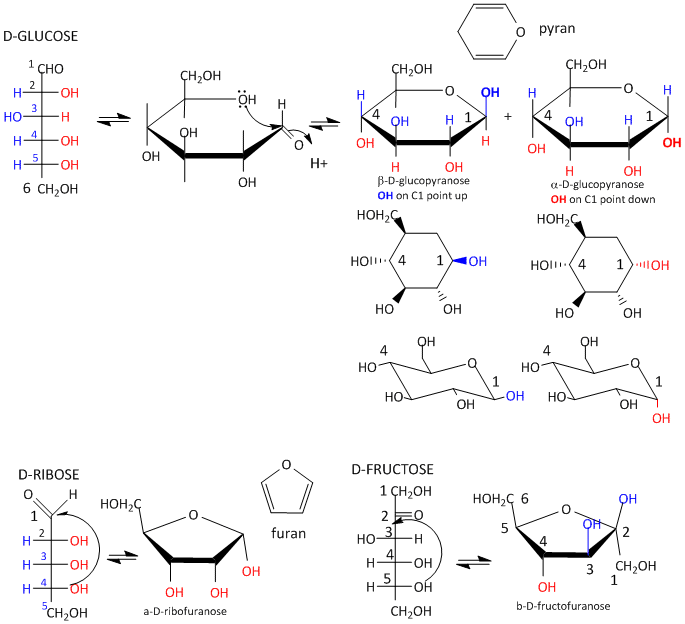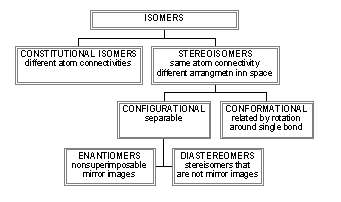Carbohydrate Chemistry and Glycobiology: A web tour
Monosaccharides Structures
Sugars can be defined as polyhydroxy aldehydes or ketones. Hence the simplest sugars contain at least
three carbons. The most common are the aldo- and keto-trioses, tetroses, pentoses, and hexoses. The simplest 3C sugars are
glyceraldehye and dihydroxyacetone.
Glucose, an aldo-hexose, is a central sugar in metabolism. It and other 5 and 6C sugars can cyclize through
intramolecular nucleophilic attack of one of the OH's on the carbonyl C of the aldehyde or ketone. Such intramolecular reactions
occur if stable 5 or 6 member rings can form. The resulting rings are labeled furanose (5 member) or pyranose (6 member) based
on their similarity to furan and pyran. On nucleophilic attack to form the ring, the carbonyl O becomes an OH which points
either below the ring (a anomer) or above the ring (b anomer).

Monosaccharides in solution exist as equilbrium mixtures of the straight and cyclic forms. In solution,
glucose (Glc) is mostly in the pyranose form , fructose is 67% pyranose and 33% furanose, and ribose is 75% furanose and 25%
pyranose. However, in polysaccharides, Glc is exclusively pyranose and fructose and ribose are furanoses.
Sugars can be drawn in the straight chain form as either Fisher projections or perspective structural
formulas.

Cyclic forms can be drawn either as the Haworth projections, which shows the molecule as cyclic and planar
with substituents above or below the ring) or the more plausible bent forms (showing Glc in the chair or boat conformations,
for example). b-D-glucopyranose is the only aldohexose which can be drawn
with all its bulky substituents (OH and CH2OH) in equatorial positions, which probably accounts for its widespread
prevalence in nature.

Haworth projections are more realistic than the Fisher projections, but you should be able
to draw both structures. In general, if a substituents points to the right in the Fisher structure, it points down in
the Haworth. if it points left, it points up. In general, the OH on the a-anomer points down (ants down) while on the b-anomer it points
up (butterflys up).

Figure: A more rigorous view of the relationship between the anomeric OH and the
OH on the last chiral C of a sugar.

The most common monosaccharides (other than glyceraldehyde and dihydroxyacetone) which you need to know
are shown below.

The mirror image of D-Glc is L-Glc. For common sugars, the prefix D and L refer to the center of asymmetry
most remote from the aldehyde or ketone. By convention, all chiral centers are related to D- glyceraldehyde, so sugar isomers
related to D-glyceraldehyde at their last asymmetric center are D sugars.
Isomers
Sugars can exists as either configurational isomers (interconverted only by breaking covalent bonds) and
conformational isomers. The figure below reviews different types of isomers.

The configurational isomers include enantiomers (stereoisomers that are mirror images of each other),
diastereomers (stereoisomers that are not mirror images), epimers (diastereomers that differ at one stereocenter),
and anomers (a special form of stereoisomer, diastereomer, and epimer that differ only in the configuration around
the carbon which was attacked in the intramolecular nucleophilic attack to produces the a and b isomers).

Sugars can also exist as conformational isomers, which interchange without breaking covalent bonds. These
include chair and boat conformations of the cyclic sugars.

Monosaccharide Derivatives
Many derivatives of monosaccharides are found in nature. These include
- oxidized forms in which the aldehyde and/or alcohol functional groups are oxidized to carboxylic acids
- phosporylated forms in which phosphate is added by ATP to form phosphoester derivatives
- amine derivatives such as glucosamine or galactosamine
- acetylated amine derivatives such as N-Acetyl-GlcNAc (GlcNAc) or GalNAc
- lactone forms (intramolecular esters) in which an OH group attacks a carbony C that was previously oxidized
to a carboxylic acid
- condensation products of sugar derivatives with lactate (CH3CHOHCO2-)
and pyruvate, (CH3COCO2- ), both from the glycolytic pathway, to form muramic
acid and neuraminic acids, (also called sialic acids), respectively.

In the above figure, N-acetylmuramic acid, found in bacterial cell walls, consists of GlcNAc in ether
link at C3 with lactate, while N-acetylneuraminic acid results from a intramolecular cyclization of an condensation product
of ManNac and pyruvate.
Figure: Is sialic acid the big difference between humans and chimps?

Chemistry of Sugars - Hemiacetals, Acetals, Disaccharides,
Monosaccharides that contain aldehydes can cyclize through intramolecular nucleophilic attack of an OH
at the carbonyl carbon in an addition reaction to form a hemiacetal (hemiketal if attack on a ketone). On the addition of
acid (which protonates the anomeric OH, forming water as a potential leaving group), another alcohol can add forming
an acetal (or ketal from a ketone) with water leaving.

If the other alcohol is a second monosaccharide, a dissacharide results. The acetal (or ketal) link bonding
to the two monosaccharides is called a glycosidic link. Links between the two sugars can be either a (if the OH on C1 involved in the glycosidic link is pointing down) or b
(if the O on C1 involved in the glycosidic link is pointing up). Since sugars contain so many OH groups which can act as the
"second" alcohol in acetal (or ketal) formation, links between sugars can be quite diverse. These include a and b forms of 1-2, 1-3, 1-4, 1-5, 1-6, 2-2, etc. links. For
example:
- lactose: Gal(b 1->4)Glc
Since Glc is attached to Gal through the OH on C4, its anomeric carbon, C1, could revert to the noncyclic aldehyde form.
This aldehyde is susceptible to oxidation by reagents (Benedicts Solution - with citrate, Fehlings reagent - with tartrate) which are subsequently reduced. In both reagents, reducing sugars reduce a basic
blue solution of CuSO4 (Cu2+) to form a brick red precipate of Cu2O (Cu+).
Sugars (monosaccharides, dissacharides and polysaccharides which can form an aldehyde at C1 or have an a-hydroxymethyl
ketone group which can isomerize to an aldehyde under basic conditions (such as fructose) are called reducing sugars.
These oxidizing agent are mild and react with aldehydes and not ketones.
- sucrose: Glc(a 1->2)Fru. Since Fru is attached
through the anomeric OH of this ketose, the Fru is not in equilibrium with its straight chain keto form, and hence sucrose
is a nonreducing sugar.
The glycosidic (acetal or ketal) link can be cleaved by hydrolysis, just as the peptide bond in proteins.

Figure: A closer look at reducing and nonreducing sugars: lactose and maltose

Great CHO Web Links

